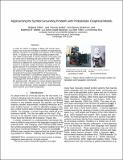Approaching the Symbol Grounding Problem with Probabilistic Graphical Models
Author(s)
Tellex, Stefanie A.; Kollar, Thomas Fleming; Dickerson, Steven R.; Walter, Matthew R.; Banerjee, Ashis; Teller, Seth; Roy, Nicholas; ... Show more Show less
DownloadTellex_Approaching the symbol.pdf (713.2Kb)
OPEN_ACCESS_POLICY
Open Access Policy
Creative Commons Attribution-Noncommercial-Share Alike
Terms of use
Metadata
Show full item recordAbstract
In order for robots to engage in dialog with human teammates, they must have the ability to map between words in the language and aspects of the external world. A solution to this symbol grounding problem (Harnad, 1990) would enable a robot to interpret commands such as “Drive over to receiving and pick up the tire pallet.” In this article we describe several of our results that use probabilistic inference to address the symbol grounding problem. Our specific approach is to develop models that factor according to the linguistic structure of a command. We first describe an early result, a generative model that factors according to the sequential structure of language, and then discuss our new framework, generalized grounding graphs (G3). The G3 framework dynamically instantiates a probabilistic graphical model for a natural language input, enabling a mapping between words in language and concrete objects, places, paths and events in the external world. We report on corpus-based experiments where the robot is able to learn and use word meanings in three real-world tasks: indoor navigation, spatial language video retrieval, and mobile manipulation.
Date issued
2011Department
Massachusetts Institute of Technology. Computer Science and Artificial Intelligence Laboratory; Massachusetts Institute of Technology. Department of Aeronautics and Astronautics; Massachusetts Institute of Technology. Department of Electrical Engineering and Computer ScienceJournal
AI Magazine
Publisher
Association for the Advancement of Artificial Intelligence
Citation
Tellex, S. et al. "Approaching the Symbol Grounding Problem with Probabilistic Graphical Models" AI Magazine 32.4, Winter 2011.
Version: Author's final manuscript
ISSN
0738-4602